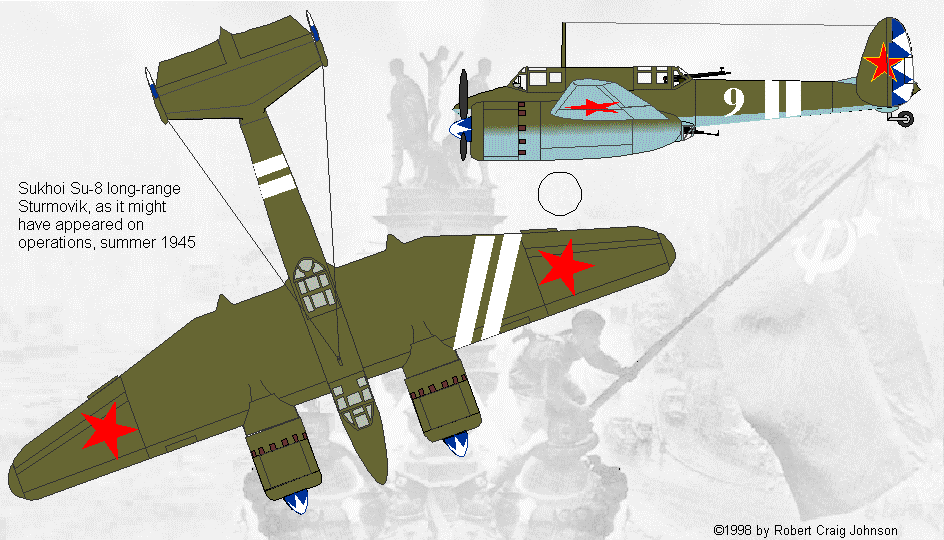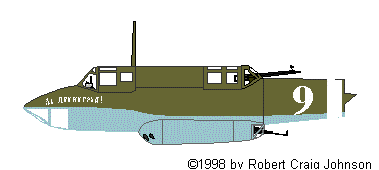
Shortly after the start of the new year 1942, with the German invasion just 6 months old, Kremlin planners were already preparing for the moment when the Red Army would go over to the offensive and pursue the enemy across the vast spaces of western Russia. For this, they reasoned, the excellent Il-2 and Su-6 assault aircraft would need the assistance of a larger, longer-ranging aircraft, preferably with twin engines. The large aircraft would strike at columns of retreating troops and vehicles far ahead of the front lines, while the smaller Shturmovik airplanes concentrated on close support along the forward edge of battle. The enemy would thus have no respite, even in flight, and every attempt at tactical disengagement or regrouping would be likely to turn into a route. Kremlin planners called this airplane the DDBsh (the Russian abbreviation for "twin-engined, long-range armored attacker") and ordered two prototypes from Pavel Sukhoi's design bureau.
Under the desperate conditions prevailing in contemporary Soviet Russia, nothing much could be done about Project B, as the proposed aircraft was also known. But, as the war began to turn against the Germans and their allies, the Kremlin committee's far-sightedness became increasingly evident. By the winter of 1943-1944, when the first prototypes appeared, Germany's retreat to the west was already at times so precipitous that the Il-2s could not reach them from their most advanced landing grounds. Soon, advanced Soviet forces would be outrunning their air support as well.

Sukhoi's Su-8 emerged as the most powerful, most heavily armed, and best protected
attack aircraft of the war. The designers set out to build the smallest airframe that could
carry the requisite fuel and two of the most powerful engines available, Shvetsov ASh-71F
18-cylinder air-cooled radials each offering 2100 hp.  The narrow forward fuselage housed the pilot, a large fuel tank, and the radio operator/air
gunner in a fully structural armored shell up to 15-mm thick. Extensive bullet-proof glazing
in the canopy and lower nose gave the pilot a good view for this type of aircraft. Over 1600 kg of
armor was used in all. Twin fins and rudders provided redundancy in the event of damage and gave
the air gunner a better field of fire above and to the rear. Defensive armament consisted of a
12.7-mm Beresin machine gun flexibly mounted in the rear cockpit (or in a small power-driven turret,
according to some sources) and a 7.62-mm ShKAS machine gun firing from a ventral position. The
aircraft spanned 67 ft 1 in, was 44-ft 7-in long, and had a wing area of 646 sq-ft. Empty they
weighed about 20,000 lbs, loaded about 27-29,000 lbs.
The narrow forward fuselage housed the pilot, a large fuel tank, and the radio operator/air
gunner in a fully structural armored shell up to 15-mm thick. Extensive bullet-proof glazing
in the canopy and lower nose gave the pilot a good view for this type of aircraft. Over 1600 kg of
armor was used in all. Twin fins and rudders provided redundancy in the event of damage and gave
the air gunner a better field of fire above and to the rear. Defensive armament consisted of a
12.7-mm Beresin machine gun flexibly mounted in the rear cockpit (or in a small power-driven turret,
according to some sources) and a 7.62-mm ShKAS machine gun firing from a ventral position. The
aircraft spanned 67 ft 1 in, was 44-ft 7-in long, and had a wing area of 646 sq-ft. Empty they
weighed about 20,000 lbs, loaded about 27-29,000 lbs.
The offensive armament was, of course, the aircraft's real reason for being, and here the design team excelled themselves. The main armament consisted of a battery of heavy cannon sized to defeat even the heavy Tiger and Panther tanks. The guns were housed in a broad, shallow pod under the center fuselage. The first prototype had four 37-mm 11P-37 (later NS-37) automatic cannon, each loaded with 50-round clips by the air gunner. Each gun could fire 735-gram shells at about 250 shots/min with a muzzle velocity of 900 meters/sec. They would penetrate 40-mm armor at any angle up to 45 degrees. In the second prototype, these weapons were supplanted by a quartet of 45-mm OKB-16-45 (later NS-45) automatic antitank guns, essentially the same weapon with a larger bore and shorter barrel. These formidable weapons fired 1065-gram shells at the same rate with a muzzle velocity of 850 meters/sec, and could guarantee penetration of 58-mm armor. These, too, were clip-fed in the prototype. But the OKB-16 design team already had a fully automatic feed system in test. On their own, these guns fired approximately 1 ton/min, the heaviest weight of fire achieved by any wartime aircraft. For sighting and for attacks on soft targets, eight 7.62-mm ShKAS machine guns were mounted in the wings immediately outboard of the propellers, each gun being capable of rates of fire between 1800 and 2700 rounds/min. In addition, four 150-kg FAB150 general-purpose bombs could be carried in bays between the engines and the wing guns.
Many, perhaps most, heavily armored attack aircraft have emerged overweight, underpowered, and ill-handling. Even the successful ones were often tolerated for their utilitarian virtues rather than loved for their flying qualities. But the Su-8 was reportedly an excellent airplane, with first-rate handling at all design weights. Maximum speed was 311 mph at sea level, 342 mph at 15,000 ft. It could takeoff in 1300 ft and land in 1528 ft at a modest 87 mph. It could climb to 10,000 ft in 7.3 min and to 16,000 ft in 9 min. Service ceiling was 28,000 ft. Range with maximum weapons load was 373 miles, 932 miles without the bombs.
By the time the Su-8 appeared, however, its time was already past, in the eyes of officialdom at least. Russia was clearly winning the war, and anything that might interfere with the production of the existing, war-winning aircraft types was frowned upon. No doubt this was the right decision, given the outcome. But there can also be little doubt that many a Soviet soldier would have been glad of the assistance of this last and greatest of the Shturmoviks, especially during the last, frantic dash for Berlin, when Soviet spearheads often faced elephantine heavy tanks 150 miles or more from the nearest air support.
© 1998 by Robert Craig Johnson.